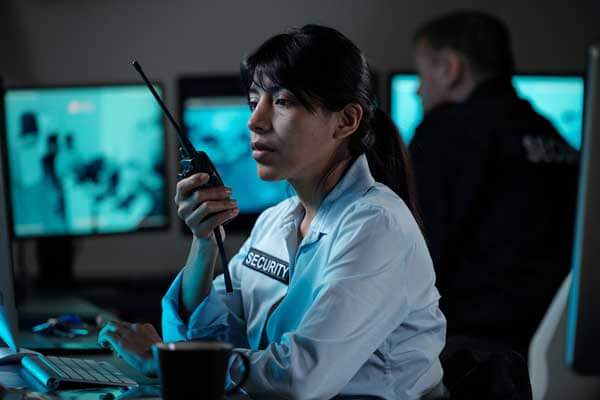At its core, NG911 is a new kind of partnership where human intuition and machine accuracy combine to enhance telecommunicator capabilities, improve results, and speed up response times while preserving the empathy and judgment that only humans are capable of.
It’s 2a.m. and a 911 emergency call-taker hears a panicked voice screaming through their headset: “My house is on fire and I can’t find my daughter!” The telecommunicator’s heart races, but their training quickly kicks in. While keeping an eye on more incoming calls, they calm the caller, note important information, ask for location, and immediately dispatch emergency responders. This is just one example of the high-stakes world of 911. A world where every second counts and every decision can mean life or death.
Every day, this scene plays out at public safety answering points (PSAPs) all over the country. Thankfully, Next Generation 911 (NG911) is revolutionizing how these unsung heroes carry out their jobs. Unlike traditional 911 systems, NG911 improves emergency response by integrating real-time data, precise geolocation, and multimedia inputs. At the heart of this transformation are PSAP next gen vendors who provide advanced solutions to support our 911 call-takers.

In the past, emergency responders could only be reached by voice calls. 911 telecommunicators experienced extreme stress when they had to operate through a single channel, especially during large-scale disasters. Their jobs required them to think fast, multitask, and maintain their emotional stability under extreme pressure and without the right resources. Their already difficult jobs were made even more difficult by inadequate caller location data, language barriers, and information overload.
The answer? You guessed it, NG911.
Thanks to innovative PSAP next gen vendors, NG911 systems can now provide a plethora of new channels to reach first responders. Telecommunicators can now receive live text messages, video streams, automated crash notifications, and real-time medical data. Callers can even be located within feet of their emergency thanks to pinpoint geolocation that uses data to automatically share from smart devices and connected cars.
In general, this development creates new opportunities for quicker and better decision-making for telecommunicators. And most importantly, telecommunicators still have a vital role to play. NG911 only improves their capabilities rather than replaces them, making sure that human judgment guides each emergency response.
Language barriers have long posed challenges to timely emergency response, particularly in diverse communities. Today, NG911 systems, developed by leading PSAP next gen vendors, integrate AI-driven translation capabilities to overcome these obstacles in real time. For example, with NG911 technology when a telecommunicator receives a call from a Spanish-speaking mother whose child is in distress, the system provides immediate transcription and translation, enabling the telecommunicator to deliver critical, life-saving instructions without delay. By bridging language gaps without compromising human connection, these technologies help confirm that every caller is understood.
In a high-volume PSAP environment, calls can arrive faster than telecommunicators are able to manage effectively. To support faster prioritization, leading PSAP next gen vendors have introduced automated triage algorithms as part of NG911 systems. These tools assess incoming calls based on severity, making sure that life-threatening emergencies are identified and prioritized ahead of lower-risk incidents. More importantly, these algorithms are designed to assist, not replace, telecommunicators. Instead it allows them to concentrate their expertise where it is needed most. Ethical development remains a core principle, with vendors emphasizing transparency and reliability to guarantee that telecommunicators maintain full confidence and control over every decision.
Accurately locating callers has historically been one of the most significant challenges in emergency response. More particularly, in dense urban environments and remote areas. Through the integration of advanced geospatial analytics, NG911 systems developed by PSAP next gen vendors now deliver precise, real-time location data. Enhanced GIS platforms can pinpoint callers within meters. This includes multi-story buildings or even deep within a national park. This capability allows telecommunicators to direct responders with greater speed and confidence. Designed for seamless integration, these solutions prioritize interoperability and intuitive operation. Therefore, ensuring that telecommunicators have the critical information they need without disruption to existing workflows.
The work of a telecommunicator is emotionally, mentally, and physically demanding. Fielding call after call, often in crisis situations, they carry the weight of every decision made in the critical first moments of an emergency. Over time, this constant exposure to high-stress environments contributes to fatigue and burnout, a growing concern across PSAPs nationwide.
Next Generation 911 is beginning to change that.
With the help of advanced solutions developed by leading PSAP next gen vendors, NG911 systems now automate routine tasks, organize incoming data more clearly, and provide real-time support. Which, in turn, frees up telecommunicators to focus on what matters most: listening, guiding, and making quick, informed decisions.
Just as important, these systems are designed with the user in mind. Interfaces are clean, intuitive, and built to minimize cognitive load. This way the technology supports the human, not the other way around.
Effective emergency response continues to depend on the telecommunicator’s role as the NG911 landscape develops. This evolution, which is driven by cutting-edge tools from reputable PSAP next gen vendors, is about more than just modernizing technology. It’s about empowering professionals to work at their best. At Synergem Technologies, we know that when human expertise and intuitive systems collaborate, genuine impact can be achieved. We are contributing to the development of a faster, smarter, and more resilient public safety future by providing solutions designed to complement, not replace, the individuals making the call.